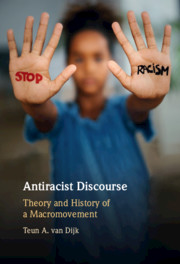Book contents
- Antiracist Discourse
- Antiracist Discourse
- Copyright page
- Contents
- Acknowledgments
- 1 Introduction
- 2 Theoretical Framework
- 3 First Writings against Slavery
- 4 Abolition Discourse of the Quakers
- 5 Black Resistance against Slavery and Discrimination
- 6 The Civil Rights Movement
- 7 Jewish Resistance against Antisemitism
- 8 Postwar Antiracist Discourse from UNESCO to Black Lives Matter
- 9 Conclusions
- References
- Index
7 - Jewish Resistance against Antisemitism
Published online by Cambridge University Press: 02 April 2021
- Antiracist Discourse
- Antiracist Discourse
- Copyright page
- Contents
- Acknowledgments
- 1 Introduction
- 2 Theoretical Framework
- 3 First Writings against Slavery
- 4 Abolition Discourse of the Quakers
- 5 Black Resistance against Slavery and Discrimination
- 6 The Civil Rights Movement
- 7 Jewish Resistance against Antisemitism
- 8 Postwar Antiracist Discourse from UNESCO to Black Lives Matter
- 9 Conclusions
- References
- Index
Summary
In the 19th century in Germany increasing nationalist discourse by protestant professors engaged in radical antisemitic discourse, sources of Nazi discourse a century later. After earlier resistance against antisemitic practices in earlier centuries, some Jewish intellectuals critically and ironically examined these discourses and their conceptions of racial hierarchies.for instance Saul Ascher, Moritz Lazarus, in Germany, and Bernard Lazare in France. In the early 20th century other Jewish scholars critized antisemitism, for instance Nathan Birnbaum, Constantin Brunner, Julius Goldstein, and under Nazism also Victor Klemperer, Lio Feuchtwanger, Fritz Bernsein, and the philosophers of the Frankfurt School and other refugees.
Keywords
- Type
- Chapter
- Information
- Antiracist DiscourseTheory and History of a Macromovement, pp. 153 - 198Publisher: Cambridge University PressPrint publication year: 2021

